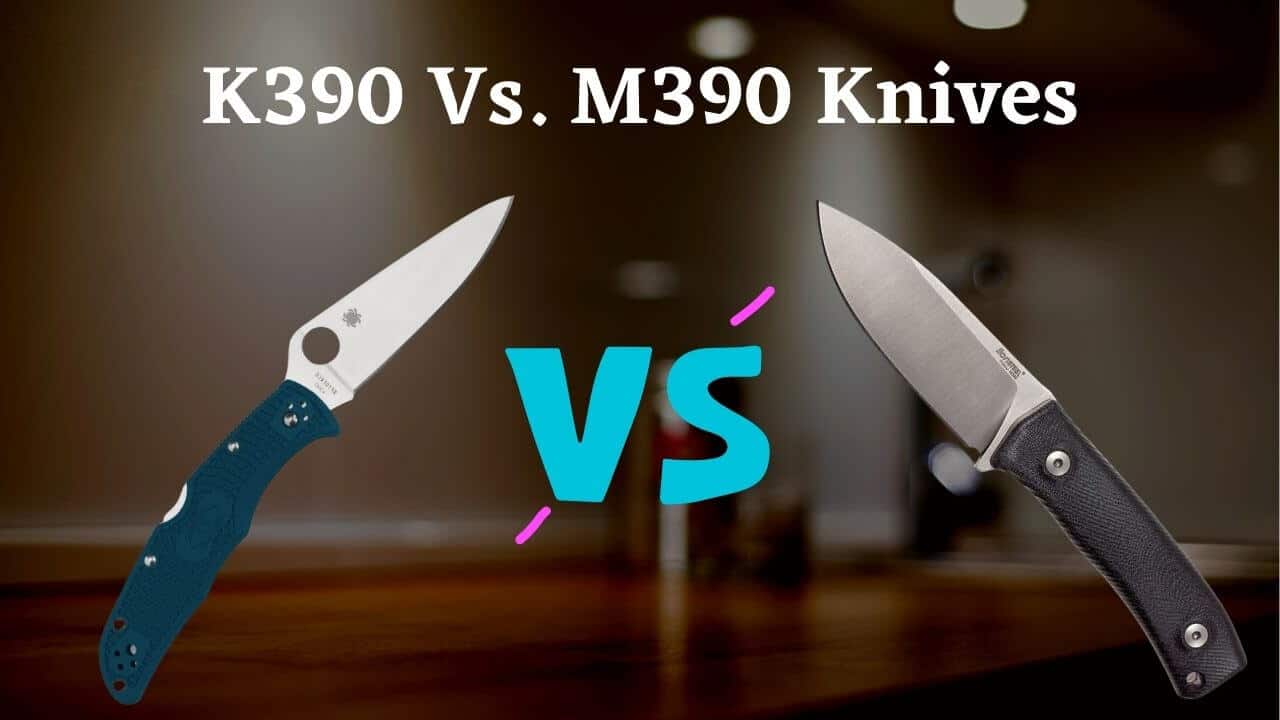Last Updated on May 19, 2023 by River Tree Farms
Knives are a great tool to have in your space. They come in handy for so many situations. Whether at home or out camping, they have a knife that works for you is very important.
If you’re a knife enthusiast, you may have heard of K390 and M390 knives. These two types of steel are a massive deal among knife manufacturers and collectors, but they can be hard to tell apart.
Can you tell what makes K390 and M390 special? And how do they compare to one another? In this article, we will discuss and compare K390 and M390 knives. We will talk about what makes them different from one another and which is better for you to use.
K390 Vs. M390 Knives Comparison chart:
Let us have a quick comparison between the two before we dig into the details
| Specifications | K390 | M390 |
| Hardness (HRC) | 64-65 | 60-62 |
| Composition | Carbon(2.47%) Chromium(4.25%) Molybdenum(3.80%) Manganese(0.40%) Vanadium(9.00%) Tungsten(1.0%) Cobalt(2.00%) Silicon(0.55%) | Carbon(1.9%) Chromium(20%) Molybdenum(1% Manganese(0.3%) Vanadium(4%) Tungsten(0.6%) Silicon(0.7%) |
| Edge retention | Excellent | Excellent |
| Wear Resistance | Excellent | Good |
| Corrosion Resistance | Fairly good | Excellent |
For general comparison in terms of rating on a scale of 1 to 10, here is another quick comparison table:
| Specifications | K390 | M390 |
| Edge Retention | 8/10 | 8/10 |
| Sharpness ease | 4/10 | 5/10 |
| Corrosion Resistance | 3/10 | 8/10 |
| Toughness Level | 6/10 | 6/10 |
1. K390 Stainless steel (overview + Features)
[amazon box= “B087YPMSZM, B08HR4NHCG, B0942PH19N” price=”none” template= “table”]
K390 steel is a High-end Cold work tool steel produced by Bohler-Uddeholm, an Australian company. It is very high in Vanadium which gives it the advantage of being very tough and having excellent wear resistance. The K390 steel is prevalent in the knife industry, cutting tools, and cold-forming Operations.
Let’s generally talk about the composition of K 390 steel:
- 2.4% of Carbon
It has a standard content of Carbon because very high contents of Carbon decrease strength. However, this level of Carbon acts great in the hardness of the steel and improves wear/corrosion resistance.
- 4.25 Chromium
This is very good for good edge retention and tensile strength and enhances corrosion and wear resistance.
- 3.8% Molybdenum
Good for machine use and improves strength.
- 0.4% Manganese
This makes it brittle and increases its hardness.
- 9% Vanadium
Good for hardening and improves wear resistance.
- 1% Tungsten
It is good in wear resistance and hardness.
- 2% Cobalt
It is good in enhancing the function ability of all the other components. It acts as a ‘catalyst.’
- 0.55% Silicon
Good in strength improvement.
This content, therefore, gives K390 the following features:
- High hardness and excellent edge retention.
- Good, though not excellent, corrosion resistance because it is semi-steel because it only has 4.25% Chromium which is the component that offers high corrosion resistance.
- Excellent wear resistance since it is very hard, making it very durable.
- Hard to sharpen. It is tough to sharpen it since the harder the steel is, the harder it is to sharpen it.
- It has good machinability since it has standard and uniform mechanical properties.
- It is very tough because the steel is hard, thus making it brittle and having high impact resistance.
Advantages of K390 Stainless Steel:
- It has high hardness, thus being durable.
- Good in-wear resistance
- Great edge retention
- Fairly good corrosion resistance, therefore, less prone to rust.
- It has good machinability
2. M390 Stainless Steel (overview + Features)
[amazon box= “B09HWQNTV2, B01MCY6TIG, B08V4L876T” price=”none” template= “table”]
The Bohler-Uddeholm M390 steel is the perfect type of steel used by chefs in the form of a knife. It is challenging and one of the hardest steel for manufacturing knives and cutting tools. The blade is perfect and holds an edge longer than most available steel.
Looking at its composition:
- 1.9% Carbon
It is very tough due to this level of Carbon.
- 20% Chromium
This is the essential component of any steel. It is good in improving hardness and corrosion resistance.
- 1% Molybdenum
Good in edge sharpening and strengthening the steel under very high temperatures.
- 0.3% manganese
Adds to the strength of the steel.
- 4%Vanadium
Vanadium aids in the distribution of grain during the process of powder metallurgy. It is also a potential wear resistance improver.
- 0.6%Tungsten
It boosts the wear resistance of the steel.
- 0.7%Silicon
It is perfect for giving hardness to steel.
M390 has the following features contributed to its features:
- High wear resistance makes it tough and durable, and it has high edge retention.
- High toughness is favorable to all known activities of steel used for cutting.
- Great grind ability, perfect for grinding with a machine tool.
- Excellent corrosion resistance making it less prone to rust.
- Has a high mirror finish and polishability.
Advantages of M390 Stainless Steel:
- It is durable since it is solid steel with high corrosion resistance.
- It has very high corrosion resistance and is thus less prone to rust.
- It is worn and tear-resistant.
- It has excellent edge retention.
- It is adequately stainless due to the high level of chromium.
Related Post: N690 Vs. M390 Knives
Similarities Between K390 Vs M390 Knives
K390 and M390 are incredibly similar in composition. They share nearly identical amounts of the same elements, and their properties are also very similar. This makes them functionally almost indistinguishable from one another. Let’s look much more into their similarities, including:
- Hardness
We consider both K390 and M390 relatively complex because they are above 60 HRC. However, the edge retention of M390 is slightly better than K390, accredited to its higher chromium levels.
- Strength
Both steel sheets are pretty fragile, with approximately 22 ft-lbs at 60 RC, whereas we know solid steel goes up to 50 ft-lbs at 60 RC. Both can be strengthened by thickening their blade.
- Carbides Range
They make knives stronger, ranging from approximately 15%-17%, which gives them the advantage of being more durable.
Differences Between K390 Vs M390 Knives
As you can see, the two steel sheets share many similarities, but there are a few notable differences.
K390 knives have more chromium than M390 knives. This means that a K390 knife is more corrosion resistant and holds its edge longer than M390 because this element helps with that. This guarantees a K390 knife resistance to rust compared to M390, which is semi-stainless in that it is very little rust-free.
Being a tough M390 knife is a little bit tougher than a K390 knife. This means that the M390 knife cannot be easily fractured due to its toughness.
K390 knives also have higher carbon content than M390 knives. This means it is harder and can even be hardened further, which helps it hold its edge longer. Therefore, K390 has more durability than M 390
K390 also has more Vanadium than M390, which means it can better resist wear and maintain an edge for more extended periods.
Molybdenum is one aspect where M390 beats out K390; it has much more of this valuable element, so it resists softer metals and materials better than K390 can.
A quick check on the differences includes:
- M390 knives have more toughness or, rather ability to resist.
- M390 knives are much more resistant than K390 because they are entirely stainless steel, while K390 is semi-stainless.
- M390 knives have better sharpness features compared to K390 knives. Again., it is harder to sharpen K390 knives than M390 knives.
- K390 knives have higher edge retention containing more features that improve this excellent factor.
- K390 knives are also harder, depending on their HRC levels.
Which is better, K390 or M390 Knives?
There is a lot of debate about which steel is better for producing knives. Some argue that M390 is better because of its higher corrosion resistance and wear resistance, while others argue that K390 has better edge retention regarding overall performance. Which one is right? It depends on your personal preferences and needs.
Since you are here for our suggestion, I will tell you why M390 knives will be better for you than K390 knives. Below are the reasons:
- It is strong
This is in terms of toughness. Most of its components are more durable, and you would want a strong knife that lasts longer in your kitchen.
- Ease of sharpening
An easy-to-sh sharpen knife improves your life in the kitchen and other uses. This type of knife is easier to sharpen and stays sharper for a long time. We can also consider it less time-consuming.
- It is stainless
M390 is entirely stainless, having very high levels of chromium. Stainless units are better looking and more polished, though not a very important factor to consider. They also offer a better coating that prevents rusting, and a quality K390 doesn’t possess since it is semi-stainless steel.
Frequently Asked Questions (FAQ)
Are M390 and K390 the same?
No. Though manufactured by the same company, they differ in features and components. M 390 has better favorable features due to its high chromium contents, making it stainless steel with high corrosion resistance.
Conclusion
So far, we’ve covered a lot of ground, and I feel like we are done. If you’ve been reading along, you have noticed some pretty significant differences between these two knives, specifically that they don’t seem to be all that different. And you would be right!
While there are some actual variances in the selection of materials and processes used in their creation, these two blades are more similar than not. Many knife-makers tend to use M390 for high-end cutlery, as it is considered by many to be one of the best blade steel available on the market today. Likewise, K390 is widely recognized as fantastic knife steel—though it is less ubiquitous than M390 due to its scarcity.

